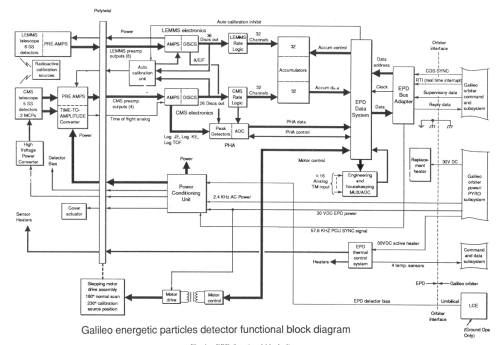The Galileo Energetic Particles Detector
From Space Science Reviews
Schematic View of EPD
 |
Schematic showing the EPD telescope heads, the overall EPD configuration, the EPD stepper motor rotation axis, and the Galileo spin axis direction. |
The detector heads are mounted on a platform and rotated by a stepper motor contained in the main electronics box. The stepper motor positions as seen looking down onto the top of the EPD along the motor rotation axis can be seen in the figure below
The combination of the satellite spin and the stepper
motor rotation (nominally stepping to the next position
after each spacecraft spin) provides 4pi steradian coverage
of the unit sphere. The zero degree ends of the two
telescopes have a clear field of view over the unit sphere
and also can be positioned behind a foreground shield/source
holder for background measurements and in-flight
calibrations. The 180 degree ends experience obscuration
effects in motor positions 4, 5 and 6 caused by the
magnetometer boom and foreground shield.
The primary elements of the system are the LEMMS/CMS
detector heads with their analog electronics, the motorized
scanning system, the digital support electronics, and the
data system. The following figure shows a functional block
diagram of the EPD.
 |
EPD functional block diagram. |
Return to main
Galileo Table of Contents Page.
Return to Fundamental
Technologies Home Page.
Updated 8/23/19, Cameron Crane
QUICK FACTS
Mission Duration: Galileo was planned to have a mission duration of around 8 years, but was kept in operation for 13 years, 11 months, and 3 days, until it was destroyed in a controlled impact with Jupiter on September 21, 2003.
Destination: Galileo's destination was Jupiter and its moons, which it orbitted for 7 years, 9 months, and 13 days.




